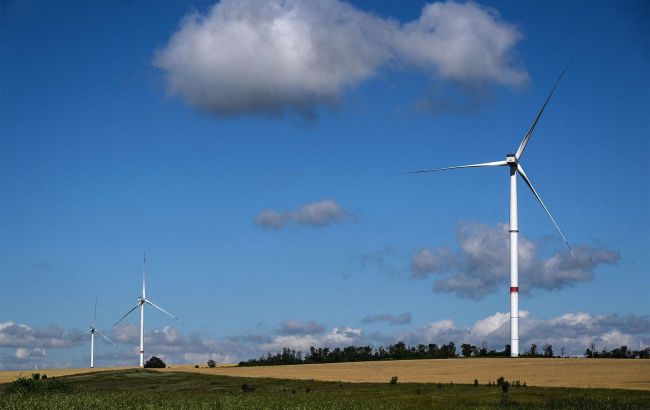8 alternative sources of renewable energy that can replace oil and gas
 Alternative sources of renewable energy to replace oil and gas (photo: Getty Images)
Alternative sources of renewable energy to replace oil and gas (photo: Getty Images)
In search of more sustainable and environmentally friendly energy sources, people have turned their attention to renewable sources. Today, there are a number of alternatives that can not only reduce dependence on oil and gas but can also become the basis for the future energy sector.
RBC-Ukraine tells about 8 sources of renewable energy that can replace oil and gas.
Sources: Investopedia, CNN, Medium, Aquatherm, BBC.
Solar energy
When we talk about renewable energy sources, we most often think of solar energy and the panels used to convert it. There are two types of such generators: photovoltaic and concentrated.
Photovoltaic generators work as follows: when a conductor or semiconductor in a battery is heated by absorbing solar radiation, a potential difference occurs between areas with different temperatures, which leads to the appearance of an electric current.
Concentrated generators collect light, which heats the liquid. It turns into steam and drives a turbine, which generates electricity. The principle of operation of such panels is different in that they are able to accumulate heat, so they remain effective at night.
In addition to generating electricity, sunlight can also be used to directly heat liquids, for example, in swimming pools and showers. A large tank installed on the roof of the eco-friendly house helps to save on electricity.
 Solar energy (photo: Fieldproxy)
Solar energy (photo: Fieldproxy)
Biofuels
Biomass is a material that is derived from living organisms, most often plants or algae. They feed on solar energy and water, reproduce efficiently, and are malleable.
By far the most common source of biomass is wood, including dead trees, branches, stumps, board waste, and wood chips.
Also on the list are crops such as millet, hemp, corn, soybeans, miscanthus, sorghum, sugar cane, and bamboo. Algae is also an excellent source of biomass due to its rapid growth rate.
All of this material can be used to produce various types of fuel, including ethanol, butanol, hydrogen, methane in gaseous form, synthetic gas, biodiesel, and others.
One of the advantages of using biomass-based energy is the efficient utilization of organic waste. Anything that is not used for food can be turned into fuel. Biofuels are already being successfully produced in the United States, Brazil, and Southeast Asia.
However, switching to biofuels does not solve the problem of global warming, as they have to be burned, just like oil and gas. However, this vegetable fuel has the advantage of being a renewable resource and is not limited like fossil energy sources.

Biofuel from corn (photo: Britannica)
Ocean energy
The world's oceans offer enormous potential for generating kinetic energy from ocean waves, tides, and currents. Some countries have already mastered methods of utilizing this potential. For example, the UK has built the world's largest wave generator called Oyster.
The principle of operation of such devices is simple: the movement of waves is transmitted to floats, which activate a piston pump. The latter directs seawater to the shore through a pipe, where it drives the rotor of a hydroelectric generator.
In addition to onshore tidal power plants, there are also underwater projects. They work on the principle of windmills installed on the seabed: powerful currents rotate the generator shaft, generating electricity.
In addition to harnessing the kinetic energy of tides and currents, there are more unconventional methods of extracting electricity from the oceans.
Due to the constant heating of the Earth's water surface by solar radiation, the world's oceans are becoming huge reservoirs of heat. It is estimated that even 5 percent of this heat can generate 10,000 GW of electricity.

A platform for ocean energy extraction (photo: The New York Times)
Wind energy
Mills were invented as early as 700-900 AD in Persia, and they acquired their characteristic image in Medieval Europe. For about 600 years, wind was the main source of energy until mankind began to use coal and steam engines on a large scale.
The first ever wind farm was developed by Professor James Blyth of Anderson College in Glasgow in July 1887. However, the locals refused to use it, considering electricity to be “the invention of Satan”.
Currently, wind energy is gaining popularity again and is used in half of the world's countries. For example, Denmark receives 56 percent of its electricity consumption from wind, Uruguay 40 percent, Lithuania 36 percent, Ireland 35 percent, and the UK 24 percent. Wind turbines are also widely used in the United States, China, Portugal, Germany, Spain, as well as in Latin America and Africa.
The advantages of wind turbines are that they allow generating electricity from the air where it is impractical to install wires. In addition, they work more efficiently at night and in winter, when solar panels, on the contrary, lose efficiency. Thus, these two energy sources complement each other.

Wind energy (photo: National Geographic Society)
Static electricity from water vapor
In 2020, scientists from Tel Aviv University discovered a new, exotic way to generate electricity. During thunderstorms, lightning is generated by the collision of water vapor particles of different densities - from droplets to ice cubes - electrifying the environment.
Repeating this process in the laboratory, the scientists found that static electricity can occur between the particles when the air humidity is over 60 percent.
By constructing sufficiently tall metal poles, they can be charged with water vapor in the atmosphere. The energy generated in this way can be transmitted through wires and used to power infrastructure.
Although the use of electricity derived from water vapor is inefficient in megacities, this method has great potential for providing cheap energy in tropical countries with high humidity.

Lightning (photo: Wikimedia)
Geothermal energy
Scientists have calculated that each decrease in the temperature of the Earth's core by 1 degree Celsius leads to the release of energy that exceeds the reserves of all proven minerals by 10,000 times. At the moment, the core temperature reaches 6,000 degrees and decreases by 300-500 degrees per billion years.
These are huge energy resources! Even at this rate of cooling of the Earth's core, the Sun will turn into a red giant before we use up the energy of the Earth's core.
Currently, geothermal sources are used to power power plants in various countries, such as Iceland, New Zealand, Italy, France, Lithuania, Mexico, Nicaragua, Costa Rica, the Philippines, Indonesia, China, Kenya, and Japan.
However, only a small part of the planet's geothermal resources is used for commercial purposes, and most often such power plants are located at the intersection of tectonic plates. Theoretically, it is possible to install wells to extract energy from the Earth's mantle almost anywhere, but so far such projects remain only at the level of theory.

Geothermal energy (photo: Climate Care)
Artificial photosynthesis
The process of photosynthesis, which normally occurs in plant cells when sunlight is exposed to water and carbon dioxide and turns into oxygen and glucose, can now be reproduced in the laboratory without the use of plants.
Scientists from the United States, Sweden, and Japan are working to develop cost-effective methods of artificial photosynthesis that can convert carbon dioxide and water into various fuels, resins, plastics, and fibers.
If this research is successful, we may be able to produce fuels and building materials directly from the air.
In addition, it is possible to use the natural processes of plants and aquatic organisms. For example, we can grow photosynthetic blue-green algae and then turn them into bioplastics and biofuels.

Algae farm (photo: Linkedln)
Infrared thermal radiation of the Earth
The sun's rays falling on the Earth's surface cause it to heat up, while the other side of the planet releases the energy accumulated during the day in the form of infrared heat radiation that is scattered in space.
Engineers from Australia have developed a device called a thermoelectric diode that generates energy during cooling rather than heating. The creation of a large enough model of this device, capable of accumulating heat during the day and releasing it at night, will lead to the creation of a solar battery that works around the clock.
Additionally, if photocells capable of capturing infrared light (similar ones are already used in night vision devices) are used to absorb the planet's thermal radiation, a so-called emission energy collector can be created. This device will make it possible to generate electricity at night directly from the atmosphere.
Covering all high-rise buildings in megacities with panels that collect thermal radiation from the planet's surface at night and scattered ultraviolet light during the day will provide an additional source of electricity.
In addition, when not in use, such emission energy collectors could be converted into passive daytime radiative cooling (PDRC) towers that would more efficiently remove heat into space than the planet's surface, which could help combat global warming.

Sunset (photo: Pexels)
Earlier we wrote about the Earth's resources, which are being depleted at a rapid pace.

